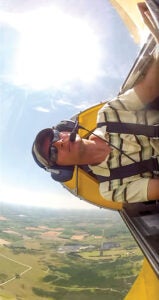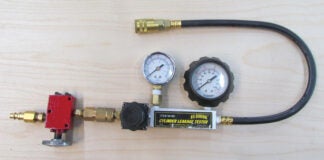
There are things from our collective past that leave me gob-smacked. Homes were painted (and tainted) with lead paint. Cigarettes were promoted for their health benefits. Baby cribs had widely spaced bars and plastic-covered mattresses poised to suffocate our curious, but weak, offspring. Kids who survived their cribs grew up to throw finned, metal spikes into the air for sport. And we flew without hearing protection, which strikes me as short sighted. Here are the advances I’ve seen in cockpit noise reduction over my 40-year flying career….
Arthritic Finger Communication System
When I remember my flying lessons from 1980, I recall fumbling for a Cessna’s mic while distorting my face to decipher the distorted commands of an overhead speaker. My 16-year-old ears struggled to hear the tower correctly. Or at all. More than once I defaulted to my instructor’s well-developed interpretations of the speaker’s eruptions. Although he lost most of his hearing navigating B-17s between England and Europe, he was proficient at deciphering the garbled messages, or more likely, he knew what the controllers were saying without having to hear them. I’m not sure he was aware he was guiding me into and out of controlled airspace with small gestures from an arthritic finger: continue, turn left, turn right, climb, descend.
On my solo flight, the speaker emitted a lengthy directive as I ascended from my second touch and go. The word count exceeded “seven-zero-four-november-papa, clear touch and go runway niner.” Without an arthritic finger to guide me, I flew left traffic rather than right traffic on that next pattern. The speaker remained silent. My interpretation skills were improving, as was my awareness for other aircraft in the pattern. However, I left the microphone, tethered to the panel by a coiled cable, exploring the floor like a dog on a leash. With my hands full trying to stay alive, I gave up getting the microphone back in its holder. So many unnecessary distractions to the task of learning to fly.
Passive Noise Reduction
By the mid-1990s, general aviation had largely moved beyond hand gesture communication and squinting to hear critical commands issued through a transistor radio speaker. The Cessna I rented was equipped with headsets that placed a speaker by each ear and blocked some of the ambient noise with semi-padded ear cups. An integrated microphone was a bonus; it remained poised by my lips rather than roaming the cockpit floor and a single finger could activate a transmission, a task that once required a whole hand. The headset aided communication but was so uncomfortable that within 30 minutes of taking flight it felt like a spike had been driven through the top of my head. I suppose that kept the headsets from walking away from the airplane and assured the airplane would be back on the ground on time for the next hourly renter.
The noise in a cockpit is generated by the exhaust, the propeller churning the air and the airflow interacting with every rivet, bolt head, airframe intersection, gap in the cowling and canopy, flying wire, antenna, etc. Drag is noise. I see many homebuilders try to attenuate the noise by adding sound-deadening insulation to the opaque surfaces of the fuselage’s interior. I’d compare that approach to insulating the walls of a home that has porous doors and windows. The hurricane-force wind outside your cockpit is also playing against the 1/8-inch-thick canopy, windshield and Plexiglas windows. The noise is transmitted through the wings and generated by every surface imperfection on the airframe. The propeller is thrashing away, wrapping its sonic signature around the entire airframe. Floor and wall insulation can’t mitigate that. What the insulation is doing, I’ll argue, is adding weight to your airframe, increasing building time and cost, covering items you may need access to, promoting corrosion and providing nesting material for critters. Rather than insulate the walls of a home that has bad doors and windows, you’d be further ahead giving everyone a blanket. Rather than soundproofing the floor and walls of the cockpit, you’d be better off with good headsets.
Active Noise (and Weight) Reduction
When I began flying Metal Illness, I equipped myself with an expensive pair of passive noise reduction headsets. They were comfortable and performed well, but I replaced them the moment I experienced active noise reduction (ANR) headsets. ANR headsets make the cockpit a far more pleasant place to be, dropping the cockpit sound level below what we experience in the cabin of a commercial airliner. I remember the first time I removed an ANR headset in flight to take off my hat. The explosion of noise was startling, almost frightening. After that, I always throttled back before removing a headset in flight.
ANR headsets block the distracting and damaging noise but can also block sounds you may want to hear. Sound can be a valuable troubleshooting tool and you should know what your cockpit sounds like with the active noise canceling turned off. I began the practice of listening to my engine with the ANR off so I’d be familiar with the normal sounds, which could help me identify a new sound that indicated trouble. Another tip: Carry extra batteries for your headsets. ANR headsets also provide passive noise reduction but once you are accustomed to the active noise canceling properties, you won’t want to finish a flight without it, especially if you are unpracticed at distorting your face to interpret radio transmissions.
ANR headsets offer obvious advantages—clear, therefore accurate, communication and advanced hearing protection—as well as not-so-obvious advantages. They reduce pilot fatigue, transfer easily to any airplane and eliminate the cost, weight and labor of attaching ineffective insulation to the airframe. Society has moved beyond lead-based paint, driving without seat belts and smoking for its health benefits. We should be beyond the days of flying without good hearing protection. Two things I know I will never do again: Bring lawn darts to a cookout and fly without ANR headsets.














Wow, Kerry, you came up a little short on your discussion of noise! Of course ANR headsets are great, totally throwing out the unwanted incoming sounds. BUT, don’t ignore the physics of sound-it is air pressure waves. If they are applied to a thin metal surface as in a fuselage skin, they will vibrate that skin and produce air pressure waves on the inside, creating noise therein! If that skin is inhibited from vibrating with a viscoelastic material (coating or insulation) or light stringers, good bye noise! This is an over simplification, of course, but we should not ignore the fact that “noise in the air” can be greatly reduced.
Good point, Howard. A 1000-word column can never cover a single topic in full, and a layman’s knowledge of a topic can never cover the range of knowledge of an expert in a field. Yes, the movement of the surfaces, like a speaker cone, transmits noise into the cockpit but, of all the other noise sources, I see that as a minor one. One that insulation probably would not offset enough to make a difference in the typical homebuilt.
thank you for the comment and expanding the scope of the conversation!